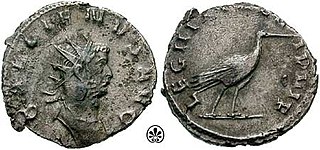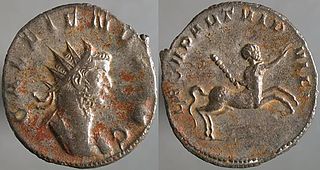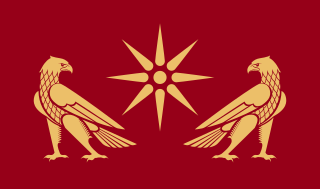The Roman legion was the largest military unit of the Roman army. A legion was roughly of brigade size, composed of 4,200 infantry and 300 cavalry in the republican period, expanded to 5,200 infantry and 120 auxilia in the imperial period.

Legio XII Fulminata, also known as Paterna, Victrix, Antiqua, Certa Constans, and Galliena, was a legion of the Imperial Roman army. It was originally levied by Julius Caesar in 58 BC, and the legion accompanied him during the Gallic Wars until 49 BC. The unit was still guarding the Euphrates River crossing near Melitene at the beginning of the 5th century. The legion's emblem was a thunderbolt. In later centuries it came to be called commonly, but incorrectly, the Legio Fulminatrix, the Thundering Legion.

Legio I Italica was a legion of the Imperial Roman army founded by emperor Nero on September 22, 66. The epithet Italica is a reference to the Italian origin of its first recruits. There are still records of the I Italica on the Danube border at the beginning of the 5th century. The emblem of the legion was a boar.

Legio I Minervia was a legion of the Imperial Roman army founded in AD 82 by emperor Domitian (r. 81–96), for his campaign against the Germanic tribe of the Chatti. Its cognomen refers to the goddess Minerva, the legion's protector. There are still records of the I Minervia in the Rhine border region in the middle of the 4th century. The legion's emblem is an image of goddess Minerva.
Legio XXX Ulpia Victrix was a legion of the Imperial Roman army. Their emblems were the gods Neptune and Jupiter and the Capricorn. Ulpia is Trajan's own gens (Ulpia), while the cognomen "Victrix" means "victorious", and was awarded after their valiant behaviour in the Dacian wars. The legion was active until disbandment of the Rhine frontier in the beginning of the 5th century.

Legio II Traiana, was a legion of the Imperial Roman army raised by emperor Trajan, along with XXX Ulpia Victrix, for the campaigns in Dacia. Records of the II Traiana Fortis have been recovered from Egypt dating to the middle of the 5th century. The legion's emblem was the demi-god Hercules.

Legio XXII Primigenia was a legion of the Imperial Roman army dedicated to the goddess Fortuna Primigenia. Founded in AD 39 by the emperor Caligula for use in his campaigns in Germania, the XXII Primigenia spent much of their time in Mogontiacum up to the end of the 3rd century. The legion's symbols were a Capricorn and the demigod Hercules.

Legio III Italica was a legion of the Imperial Roman army founded in AD 165 by the emperor Marcus Aurelius, for his campaign against the Marcomanni tribe. The cognomen Italica suggests that the legion's original recruits were mainly drawn from Italy. The legion was still active in Raetia and other provinces in the early 5th century.

Legio II Parthica was a legion of the Imperial Roman army founded in AD 197 by the emperor Septimius Severus, for his campaign against the Parthian Empire, hence the cognomenParthica. The legion was still active in the beginning of the 5th century. The legion's symbol was a centaur.
Lucius Artorius Castus was a Roman military commander. A member of the gens Artoria, he has been suggested as a potential historical basis for King Arthur.

The Kingdom of Armenia, also the Kingdom of Greater Armenia, or simply Greater Armenia, sometimes referred to as the Armenian Empire, was a monarchy in the Ancient Near East which existed from 321 BC to 428 AD. Its history is divided into successive reigns by three royal dynasties: Orontid, Artaxiad and Arsacid (52–428).
Lesser Armenia, also known as Armenia Minor and Armenia Inferior, comprised the Armenian–populated regions primarily to the west and northwest of the ancient Kingdom of Armenia. The region was later reorganized into the Armeniac Theme under the Byzantine Empire.

An aquila was a prominent symbol used in ancient Rome, especially as the standard of a Roman legion. A legionary known as an aquilifer, the "eagle-bearer", carried this standard. Each legion carried one eagle.
Legio II Armeniaca was a legion of the late Roman Empire. Its name could mean it was garrisoned in the Roman province of Armenia, but later, together with its twin, I Armeniaca, it was moved into the field army as a pseudocomitatensis legion. The legion is reported to have built a camp in Satala. According to Ammianus Marcellinus, in 360 AD. II Armeniaca was stationed in Bezabde with II Flavia Virtutis and II Parthica, when Shapur II besieged and conquered the city, killing many of the inhabitants. The II Armeniaca however, survived, since it is cited in the Notitia Dignitatum as being under the command of the Dux Mesopotamiae.

Legio V Macedonica was a Roman legion. It was probably originally levied in 43 BC by consul Gaius Vibius Pansa Caetronianus and Gaius Iulius Caesar Octavianus. It was based in the Balkan provinces of Macedonia, Moesia and Dacia. In the Notitia Dignitatum records from beginning of the fifth century, the legion was still stationed in Dacia, with detachments stationed in the east and Egypt.

Legio XV Apollinaris was a legion of the Imperial Roman army. It was recruited by Octavian in 41/40 BC. The emblem of this legion was probably a picture of Apollo, or of one of his holy animals.

Legio I Armeniaca was a pseudocomitatensis legion of the Late Roman Empire. The Legio I Armeniaca was probably founded in the late 3rd century by Julian the Apostate, although it could have been founded by Diocletian It is possible that the name of the legion could mean that it was originally part of the garrison of the Armeniac provinces, but the unit, together with its twin legion II Armeniaca, appears to have been included in the imperial field army. The legion was based in Bezabde until the Persians captured the area in 360. The Legion took part in Julian's invasion of the Sassanid Empire. The Notitia dignitatum records the legion as being under the command of the magister militum per Orientis around 400.

Roman Armenia refers to the rule of parts of Greater Armenia by the Roman Empire, from the 1st century AD to the end of Late Antiquity. While Armenia Minor had become a client state and incorporated into the Roman Empire proper during the 1st century AD, Greater Armenia remained an independent kingdom under the Arsacid dynasty. Throughout this period, Armenia remained a bone of contention between Rome and the Parthian Empire, as well as the Sasanian Empire that succeeded the latter, and the casus belli for several of the Roman–Persian Wars. Only in 114–118 was Emperor Trajan able to conquer and incorporate it as a short-lived province.
Armeniaca, a Latin word meaning from Armenia, may refer to :






